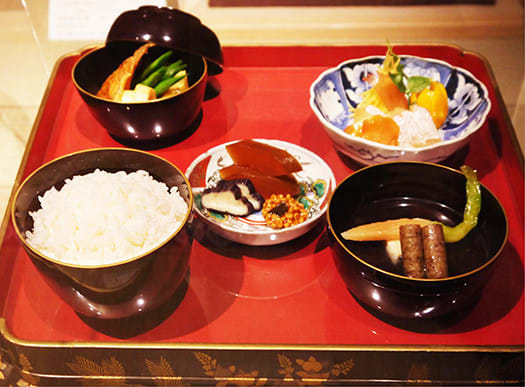

名古屋城というのは、御三家の尾張家の居城だけれど、そこは徳川ファミリーなので、江戸にいる「本家・徳川氏」が出張で京都に上洛するときには、道中の最重要拠点としてこの城郭に滞在したので、将軍の専用の「御座所」=お成り殿が造営されていた。その格式はきのうまで見た最高格式で内装が仕上げられている。ただ、そういうファミリー意識は、江戸期を通じてだんだん薄らいでいったのは、史実の通り。名古屋側では自分の家の格式は、将軍家のすぐ次、いわゆる御三家筆頭だと自認していたけれど、江戸期を通じて将軍職をこの家が継承したことはなかったことから、徐々に独立的な家風を持ったとされる。
この復元された本丸御殿は草創期の江戸幕府期のものであり、きわめて良好な関係性を将軍家と持っていた時期と言うことになる。
で、展示では「こいつら、どんなメシを食べていたんだ」という多少憎しみの匂いが感じられるわかりやすい庶民的関心事が展示されていた。わたしも、料理趣味人として興味津々。
いちばん上の写真は現代人の食事にも通じる「ごはん」と副食類の膳部。食事の仕方としてはこういう膳に食器を並べ立ててひと品ずつ鑑賞し味わう。汁物の「皮付きゴボウ」や「葉付き大根」はこういう生々しい姿で食した。刺身は赤貝・鯛に副菜が添えられている。煮物はきすを焼いたもの、麩、インゲン、イモなど。香の物はウリ類と山椒など。なかなか健康食的。ごはんがちょっと摂り過ぎ(笑)。

つづいて「二の膳」か。右上の竹の細工には「熊笹」〜昔から防腐、殺菌効果に優れいていると言い伝え、レンコン、魚卵をまぶした「造り」、鯉の造り。左下はかれい、ナス、岩茸と味噌の敷物。出ました、名古屋の味噌ですが、写真では良く視覚化されていない、残念。左上煮物。ふきと干しナマコ。中央はよくわからない箸休めか。

「三の膳」は右にうなぎの蒲焼き。左下にアイナメの付け焼き。お吸い物はかれいと芽ウド。
魚類がエネルギー摂取の主体で、さまざまな手順を加えた調理ぶりがわかる。それに比較して野菜類の摂取が少量で、しかも「見た目」重視的な摂取だと思われる。将軍さん、こういう食生活では、あんまり健康的な習慣とは言えませんよ、と言いたくなった(笑)。
わが家では高齢期を迎え健康第一の食事習慣に邁進。「ベジファースト」を徹底していて生野菜・煮野菜・酢の物などをたくさん摂取しております。タンパク源は魚と肉類をしっかり摂って、ご飯はコメとあずき主体での十穀米。それもご飯茶碗に1/2程度と節制。
現代の庶民として、なんとか徳川将軍家に一矢報いたような気分(笑)。
English version⬇
Meal menu at the Shogun's mansion.
The extravagant tableware is a sight to behold. Although we try to balance our meals with small portions and many varieties, there are not enough vegetables compared to the meals we eat at home, where we practice “veggie first”! .......
Nagoya Castle is the residence of the Owari family of the Gosanke clan, but because it belonged to the Tokugawa family, when the “Honke Tokugawa” in Edo went to Kyoto on business, they stayed at this castle as the most important base along the way, so an “Oza-sho” (palace) was built for the exclusive use of the shogun. The interior was finished in the most prestigious style we have seen until yesterday. However, it is a historical fact that such family consciousness gradually faded away throughout the Edo period. Although the Nagoya side of the family was self-identified as the first of the three so-called “Gosanke” families, immediately following the Shogun's family, the Shogun's position was never held by this family during the Edo period, and so the family gradually became more independent.
The restored Honmaru Goten dates from the pioneer period of the Edo shogunate, when the family had an extremely good relationship with the shogunate.
The exhibition displayed items of common people's interest, with a hint of hatred, such as, “What kind of food did these people eat? As a person who enjoys cooking, I was also very interested.
The top photo is a table with “gohan” (rice) and side dishes, which is also common to modern people's meals. The way to eat is to set up the dishes on such a table and appreciate and savor each dish one by one. The “burdock with skin” and “daikon radish with leaves” in the soup were eaten in their raw form. Sashimi is red clams and sea breams served with side dishes. Nimono (simmered dishes) include grilled yellowtail, fu, green beans, and potatoes. The savory dishes included cucumbers and sansho (Japanese pepper). It is quite a healthy meal. The rice is a little too much (laugh).
Next is the second course. The upper right is a bamboo work made of “kumazasa” bamboo - traditionally said to have excellent antiseptic and sterilizing properties, lotus root, “tsukuri” fish roe covered with “tsukuri” and carp. The bottom left is a carp, eggplant, and rock mushroom with a miso dressing. Here it is, Nagoya's miso, but it is not well visualized in the photo, unfortunately. Top left: simmered vegetables. Fukino and dried sea cucumber. The center is a chopstick rest which I do not understand well.
The “San no Zen” menu features broiled eel on the right. The “San-no-zen” has broiled eel kabayaki on the right, and broiled eel with tsukemono sauce on the bottom left. The soup is made of karei (dried sardines) and bud udo.
Fish is the main source of energy intake, and the various steps taken to prepare it are evident. In comparison, vegetables are consumed in small quantities and seem to be consumed with an emphasis on “appearance. I feel like saying, “Mr. Shogun, this kind of diet is not a very healthy habit” (laughs).
In my family, we are striving for health-first eating habits as we approach old age. We eat a strict “veggie first” diet, which includes lots of raw and cooked vegetables and vinegared foods. As a source of protein, we eat fish and meat, and rice is made mainly from rice and azuki beans with 10 grains of rice. I eat only about 1/2 a bowl of rice.
As a modern commoner, I feel as if I have managed to give the Tokugawa Shoguns a run for their money (laugh).




























※コメント投稿者のブログIDはブログ作成者のみに通知されます